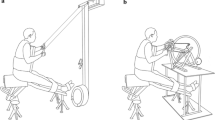Abstract
The anaerobic threshold (4 mmol/1 lactate) has rarely been described in paraplegics. Investigations with arm crank ergometry in physically unimpaired persons (3, 8) showed a smaller energy consumption corresponding to the smaller muscle mass implemented. Nevertheless, the anaerobic threshold could be demonstrated (8). Most investigations have found the oxygen uptake in wheelchair ergometry and arm cranking ergometry to be similar, and also that arm cranking training produced a better performance in wheelchair ergometry (6, 7, 9, 10). Therefore it was feasible to investigate the anaerobic threshold in paraplegics with wheelchair ergometry following a ramp protocol. Certain questions were considered: Do paraplegics reach and surpass the anaerobic threshold at 4 mmol/l lactate? And if so, is there a difference depending on their sports activity?
Access this chapter
Tax calculation will be finalised at checkout
Purchases are for personal use only
Preview
Unable to display preview. Download preview PDF.
Similar content being viewed by others
References
ARNOLD W., Israel S., Richter H., Reitmann U.: Die körperlich-sportliche Leistungsfähigkeit rollstuhlabhängiger Querschnittgsgelähmter und ihre Trainierbarkeit. Med. u. Sport 27: 15–17, 1987.
BOLDIN E.M., Lundegren H.L.: Comparative aerobic training effects of arm versus wheelchair ergometry. Med. Sci. Sports Exerc. 17: 288–289, 1985.
DAVIS J.A., Vodak P., Wilmore J.H., Vodak J., Kurtz P.: Anaerobic threshold and maximal aerobic power for three modes of exercise. J. Appl. Physiol. 41: 544–550, 1976.
FLANDROIS R., Grandmontagne M., Gerin H., Mayet M.H., Jehl J.L., Eyssette M.: Aerobic performance capacity in paraplegic subjects. Eur. J. Appl. Physiol. 55: 604–609, 1986.
GASS G.C., Camp E.M.: The maximum physiological responses during incremental wheelchair and arm cranking exercise in male paraplegics. Med. Sci. Sports Exerc. 16: 355–359, 1984.
GASS G.C., Camp E.M.: Effects of prolonged exercise in highly trained traumatic paraplegic men. J. Appl. Physiol. 63: 1846–1852, 1987.
GLASER R.M., Sawka M.N., Brune M.F., Wilde S.W.: Physiological responses to maximal effort wheelchair and arm crank ergometry. J. Appl. Physiol. 48: 1060–1064, 1980.
HOLLMANN H., Schürch P., Heck H., Liesen H., Mader A., Rost R., Hollmann W.: Kardiopulmonale Reaktionen und aerob-anaerobe Schwelle bei verschiedenen Belastungsformen. Dtsch. Z. Sportmed. 38: 144–156, 1987.
SEDLOCK D.A., Knowlton R.G., Fitzgerald P.I.: Thre effects of arm crank training on the physiological responses to submaximal wheelchair ergometry. Eur. J. Appl. Physiol. 57: 55–59, 1988.
SKRINAR G.S., Evans W.J., Ornstein L.J., Brown D.A.: Glycogen utilization in wheelchair-dependent athletes. Int. J. Sports Med. 3: 215–219, 1982.
STEININGER K., Noack W., Raetzel G.: Sportmedizinische Leistungsdiagnostik bei Rollstuhlfahrern. Dtsch. Z. Sportmed., Sonderheft: 28–33, 1987.
WICKS J.R., Lymburner K., Dinsdale S.M., Jones N.L.: The use of multistage exercise testing with wheelchair ergometry and arm cranking in subjects with spinal cord lesions. Paraplegia 15: 252–261, 1977.
Author information
Authors and Affiliations
Editor information
Editors and Affiliations
Rights and permissions
Copyright information
© 1991 Springer-Verlag Berlin Heidelberg
About this paper
Cite this paper
Rawashdeh, M., Heitkamp, HC., Jeschke, D. (1991). The Anaerobic Threshold in Paraplegics. In: Bachl, N., Graham, T.E., Löllgen, H. (eds) Advances in Ergometry. Springer, Berlin, Heidelberg. https://doi.org/10.1007/978-3-642-76442-4_61
Download citation
DOI: https://doi.org/10.1007/978-3-642-76442-4_61
Publisher Name: Springer, Berlin, Heidelberg
Print ISBN: 978-3-540-53684-0
Online ISBN: 978-3-642-76442-4
eBook Packages: Springer Book Archive




